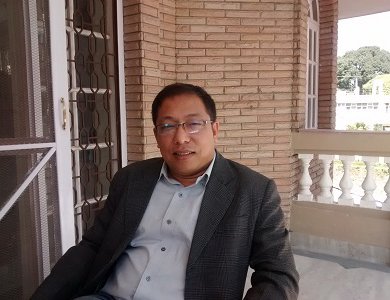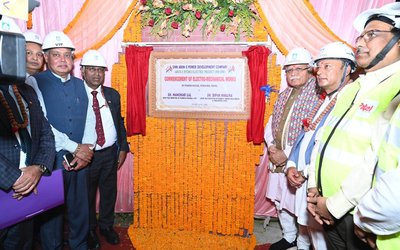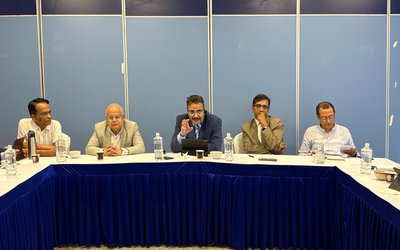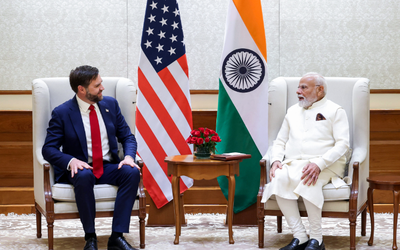
What is the state of Promotion of Sustainable Agriculture for Nutrition and Food Security Project (POSANFS)?
With the financial support of the European Union, Practical Action has initiated POSANFS (Promotion of Sustainable Agriculture for Nutrition and Food Security) project directly targeting 7,000 households, including 20 percent dalits and 50 percent women from Achham, Bajhang, Bajura and Doti districts. This project is related to food and nutrition. However, this project aims at commercialization of agriculture. If we are able to increase the income of farmers, we can help increase food and nutrition. Our major focus is commercialization of agriculture. Thus, the project is implemented through clusters which have the potential for the commercialization of agriculture.
What is the state of the project?
Events of district level inception workshops were conducted in each project district, Doti, Achham, Bajhang and Bajura. During the workshop, the concept and modality of the project were clarified among the government and non-government stakeholder organizations and the project VDCs were approved and finalized considering the objectives and working areas. Similarly, the events of Cluster level Inception Workshops were conducted in each of the project districts. The modality of the project and responsibility of clusters were clarified for the effective and efficient implementation of the project. Local level stakeholders were the participants of the workshop.
What other achievements has the project made?
The current status of the identified groups was assessed so as to develop a tangible vision and objective for project intervention. The activity was conducted in each of the identified groups in project VDCs. The assessment report presents a summary of social and gender inclusiveness and level of agriculture commercialization of each of the groups. A total of 323 groups are identified to initiate the project intervention.
What about the market scenario?
A Participatory Market Mapping Workshop was conducted in each of the clusters, in each of the project districts. The activity consisted of market analysis (Core market chain actors, Business Service Providers and Enabling Environment), validation, constraints and opportunity analysis and development of joint vision and action plan. A PMM map was validated during the workshop and a bird eye vision of current production and marketing practices for three sub-sectors (Vegetable, Spice and Goat) were identified. Moreover, a tentative production plan was sketched based on the information provided by participants.
Has the project launched any training so far?
Based on the gap analysis conducted by the project, a curriculum was developed on burning issues faced by the farmers. Four events of technical training were conducted in each of the clusters in Doti and Achham districts. The farmer participants were also supported with seed technology in BDS approach so as to ensure the increase in production of the sub-sectors.
What about the production and Market Plan?
A format was developed to identify the current trend of production and target for three years to increase the production. The format was fulfilled tracking the production of each individual, group and cluster level. The project staff from the partner organizations were oriented on the perspectives of business plan and method of business plan preparation, so as to maintain the project activities in business model.
What about the Business Development Service (BDS) Mapping?
Business Development Service Providers existing in the project areas were mapped. The BDS involved Agro-vets, LRP’s, and Cooperatives. Based on the mapped information, the BDS were selected for capacity strengthening for the existing one and a vision was made to develop a new one where there is no BDS available. Regarding cooperatives, an appropriate cooperative was selected to work with the cluster level network (CLN) members collaboratively and link the CLN with loan facility, insurance schemes and business development.
Have you formed School Led Nutrition Committee (SLNC)?
SLN Committees are formed in school of project areas and initiated to implement extracurricular activities related to nutrition and home gardening.
For result and method demonstration, farmers have been selected for vegetable sub-sector in project areas to demonstrate the performance and irrigation technology.
What is the basis for clusters?
The project selects the clusters on the basis of their potential for the commercialization of agriculture. There will be eight clusters and a cluster covers 4-5 Village Development Committees.
What are the major components?
The project aims to contribute to enhance regional food and nutritional security articulated in the periodic and multi sector nutrition plan of Nepal government. Other objectives are to improve food and nutritional security of 7,000 food insecure households in project districts.
Where is your focus?
The main focus is on production and productivity, particularly in three sectors, like goat, vegetable and spice. We will also encourage the market value chain. The project also launches nutrition campaigns. We provide the food processing technology to the farmers and to improve the value chain for spices.
How do you bring the change?
Our objective is to increase productivity of goat and vegetable/spice crops. This will be done through developed and strengthened inclusive and pro-poor value chain to commercialize goat, vegetable and spice crops, improved nutritional status of women, children and vulnerable groups, enhanced capacity of local non-state actors to constructively engage with local government for sustaining the project outcome, developed enabling environment for food and nutritional security at district.
How important is your program in the context of effects in agricultural products due to climate change?
When we talk about production and productivity, there is a link with the issue of climate change. Climate is one of the major components of agriculture development. In our program, farmers gather every week to discuss and observe the issue of climate of previous years. They do share the scenario of rainy days, intensity of rain and days of drought at present and past. They analyze all these trends including what kinds of seed is required and what kind of seed needs replacement. They discuss plant in disease and other such issues related to productivity. They discuss technology and state of agriculture. Since they have the local adaptation method, the farmers manage it. Climate has been changing for a long time and farmers have their own adaptation methods.
What change do you expect from the project in three years?
The income level of farmers will be doubled. Our total target is to double production.
The children below three years of age or the first one thousand days will have underweight strengthen and underweight release by fifty percent. Now we are weighing the children. There is also a target to reduce 50 nutrition baselines Body Marx Index (BMI).
Have you started the programs?
We have already started initial programs in the districts. Nutrition clubs have already been set up and health campaign started and the programs of kitchen garden have already moved ahead. Market management committees have already been formed at the cluster level and strengthening the agro-vet.
How do you coordinate with the government agencies?
Out of five expected results, one expected result is to build the capacity of the local stakeholders, including the government. We will provide training to enhance the capabilities of the agencies involved in food and nutrition works at the district level. We will also support the preparation of the district level food and security plan. Each district should have a district level food and nutrition security plan and this project will support its formulation.
Will you share the experiences of sustainable agriculture by Practical Actions in other districts?
Definitely. We talk about climate smart agriculture, agro-ecological based agriculture. We will also share the learning practices Practical Action has done in the country and outside the country. We have now a group on food security agenda. We are sharing.
Unlike in the traditional nutrition projects, it has a different approach. We want a more sustainable agriculture with commercial move. It includes many components. There is also this issue of access, awareness, availability, and purchasing capability.
Do you mean only through commercialization of agriculture, the food and nutrition issues will be settled?
In Nepal's context, nutrition cannot be handled only through food security because most of our farmers are small farmers with small landholding. Farmers need to be involved in off-farm activity. So far as the people of far western region are concerned, a large number of people from far west migrate to India for off farm activities. Some migrate to Kathmandu and other cities. Off farm activities have major contribution in their livelihood. Despite this, they still rely on agriculture. Their way of life is in subsistence agriculture. If we commercialize and link it with market, then it will contribute to food and nutrition security. If we tie up their productivity with market, their income will be maximized.
Where does the project contribute?
The project will contribute to food and nutrition. We cannot control seasonal migration. Despite having two incomes, people are still food insecure. We cannot change the income from migration but what we can change is the local income. Our major focus is now on women. We have been talking about the feminization of agriculture. Although more than 70 percent of agriculture related work is performed by women, agriculture policies are male biased. There is also the need to tie up agriculture with women.
- NEPAL-THAILAND: Joint Business Council
- Apr 13, 2025
- BIMSTEC SUMMIT: Nepal’s Stand
- Apr 11, 2025
- IME GROUP: Expands Into Paper Industry
- Mar 24, 2025
- CPN UML: Instigated By India
- Mar 23, 2025
- ADB’S CHIEF ECONOMIST: Nepal Reduces Poverty
- Mar 11, 2025















